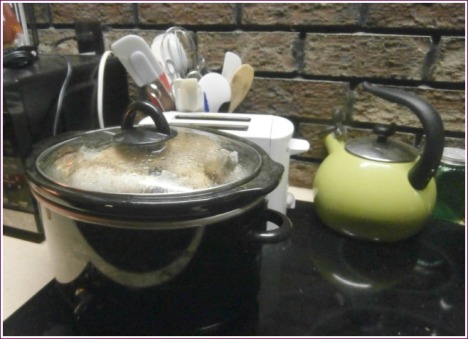I have fond memories of my Air Force days in Greece (read more
here), and especially of going out to local
tavernas or finding one near some isolated beach. Although its cognate in English, tavern, generally conjures up images of a place where men sit around tables with a mugs of beer in hand, sometimes singing chanties, a Greek taverna is the ubiquitous informal restaurant, which almost always has some kind of grill for cooking meat and tables outside, where patron sit under the shade of an arbor or umbrellas.
The typical meal that almost ordered was served in courses. First came the Greek salad, with chunks of the best tomatoes I’ve ever eaten, thickly cut pieces of juicy cucumber, and a slice or two of onion, all topped with a small slab or two of feta, several dark olives, and sometimes a tart pickled pepper. Oil and vinegar were already on the table ready for drizzling. Next arrived long stripped of battered and deep-fried zucchini and at about the same time, french fries. But think big, chunky home fries here, not thin, McDonald’s style. Along with the zucchini and potatoes appeared a small plate with the filled with a puddle of yummy tzaziki (sometimes spelled “tzatziki”), the slightly tart, yogurt-cucumber accompaniment for the zucchini and potatoes, and the soon-to-arrive, grilled meat.
Tavernas didn’t usually offer desserts, although some might have had some rice pudding, or something similar, for the asking. Usually the meal ended with a small cup of thick Greek coffee (others call this Turkish coffee), which could be ordered three ways: bitter, metrio (a Greek word I still remember, because this is what I ordered)–medium sweet, and glykos–very sweet. Some other ways to end the meal might be a small glass ouzo, the well-known Greek alcohol, something I never acquired a taste for. Generally, if something tastes like licorice, it should be licorice candy!
If there is one thing that makes me immediately think of Greece, it’s tzaziki. I never learned to make it when I lived in Greece because if I cooked for myself, I didn’t cook Greek food. However, when I got out of the Air Force and started living out in the plains of western Kansas, I began to miss the taverna food. Greek salads were easy enough to replicate, though in those days, and especially living so far from any city, finding feta cheese was difficult. I also learned to make a great pastitsio, which, for those who don’t know this casserole dish, might be described as Greek lasagna.
Because I like tzaziki so much, I have tried, based on various recipes, to make it, but I’ve never been completely satisfied with the results. One reason is because the recipes asked that liquids be drained from the yogurt overnight through a cloth in a colinder. Even when the other ingredients were added, I never felt like I ended up with very “authentic” tzaziki.
I don’t eat yogurt on a regular basis, so I haven’t paid much attention to it in the super market. However, in just the last several months, I’ve been hearing Greek yogurt being advertised, so I took a look in the dairy section. Surprisingly, there were several different brands with quite a few different flavors along with plain.

Most of what's needed to make quick, fresh tzaziki.
Just recently, by trial and error with the Greek-style yogurt, I’ve created my own tzaziki recipe that is quick, and I think compares well with that from the tavernas. I used my palate to do it without even a glance at my old Greek cookbook. I have never deep-fried anything, so I wouldn’t even attempt to make the taverna-style zucchini and french fries, but I think this tzaziki goes great with the roasted vegetables and any meat from my outdoor grill.
And now it’s grilling season again. Last year, I went to Lowe’s (read that post here) and became a first-time gas grill owner. And I have never looked back. I love taste and texture of grilled meats done on the grill, not to mention, no extra heat or greasy smoke smell in the house. But the grill basket I received for Christmas has changed my whole idea about grilling.

These roasted veggies will be even better with some tzaziki slathered on them.
I’ve found that roasting on the grill makes for more delectable vegetables than just about any other way of cooking. I’ve already tried roasting quite a few different vegetables: potatoes, carrots, onions, yellow squash, acorn squash, zucchini, okra, bell peppers, and broccoli, and I haven’t been disappointed yet. Like with grilling meat, it’s important to know your own barbeque grill, especially how to regulate the heat and where the food that you’re cooking needs to be placed on the grill so that it gets cooked like you like it, but doesn’t burn. Here’s what I do:
Roasted Vegetables on the Grill
Make sure the grill grates are clean. Then light all the burners on high, close the lid and let the grill get hot.
Prepare the vegetables by washing and cleaning them. For potatoes, cut off any blemishes or dark spots, but you don’t have to eye or peel them. Trim and cut carrots. Cut the stem and bottom ends off of vegetables like zucchini and yellow squash. Clean out the seeds from any type of peppers.
Cut the vegetables into manageable pieces–about 1/2 to 3/4 inch thick works well for most vegetables like potatoes, onions, and squash. More fragile vegetables such as bell peppers should just be quartered. Potatoes and hard squash take longer to cook that other vegetables, so if you are cooking these together with other vegetables, zap them in the microwave for a couple minutes to give them a head start; however, you don’t want them fully cooked.
To season, put the vegetable pieces in a big bowl. Splash on some olive or vegetable oil. Then sprinkle with seasonings you like, such as black pepper, red pepper, garlic powder, chile powder, ground cumin, and oregano. I also add Kroger brand salad dressing and Asian black pepper sauce. Use a couple of spatulas and gently stir to coat the vegetables with the oil and spices. I don’t use regular salt either before or afterwards, but you can lightly sprinkle on salt after the grilling.
When I’m to grill the vegetables, I turn the burner which I’ll use for them to medium, but leave the others on high. Burgers and steaks usually cook faster than the vegetables, so I start the veggies first. Place the grill basket on the grill so that you can put in the vegetables without burning yourself. You could also put the basket on a tray before you go to the grill and add the vegetables. Layer the vegetables with those that need more cooking time, like potatoes and carrots on the bottom. Scrape any remaining seasoning from the bowl onto the vegetables; move the basket to the back and close the lid. After 6=8 minutes, use a long barbeque, tong-spatula to start checking and turning the vegetables. Gently turn them 3 or 4 times throughout the cooking process to get them golden brown and done. Cooking time can vary depending on the amount and type of vegetables. Using cooking mitts, carefully remove the basket from the grill.
Homemade Tzaziki (Trip to the Outhouse Style)
- 1 small container of Greek-style yogurt (5-6 oz.)
- 1 very small cucumber or 1/2 of a larger cucumber peeled
- 1 clove garlic peeled
- 1 small scallion (green onion) including part of the top, cleaned
- 2 tablespoons cottage cheese
- 1 1/2 teaspoons vinegar (you might try lemon juice too)
- black pepper
In a food processor, pulse the garlic and green onion until very fine. Add the vinegar and pulse in. Add the cottage cheese and pulse until creamy. Add the cucumber that you’ve cut up into chunks. (If the seeds in the cucumber look mature, scoop them out and discard them. Don’t add them into the mixture.) Pulse until the cucumber is in smaller bits. Sprinkle on some black pepper and add the yogurt. Pulse until all the ingredients are just blended.
Make the tzaziki at least a couple of hours before your meal and store in the refrigerator. It will keep in a covered container for 2-4 days in the refrigerator. Serve in a bowl or on a plate with a little olive oil drizzled over the top. If your meal is more formal, serve on small individual plates.
This recipe makes about 2 cups, which should be quite enough for a 1-family meal. You could increase the amount by doubling the ingredients except for the garlic and green onion.
Filed under: It's What I Like, Maps, Geography, and Places, Talking About Food | Tagged: 6916th, 6916th Security Squadron, Air Force Security Service, Astir Beach, Athenai AF Base, Athens Greece, barbeque grill, broccoli, buying a grill, Char-Broil Quantum, cooking, french fries, gas grill, Glyfada, Greek cooking, Greek salad recipe, Greek yogurt, grill assembly, grilled vegetables, grilling, hamburgers, Home Depot, Houston Texas, Lowe's, outdoor cooking, recipe, Sears Hardware, taverna, tzatziki, tzaziki, yellow squash, zucchini | Leave a comment »





 http://jointheimpact.com
http://jointheimpact.com















